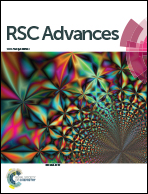Human hair-derived graphene-like carbon nanosheets to support Pt nanoparticles for direct methanol fuel cell application
Abstract
In this paper, a novel graphene-like carbon nanosheet (HGCN) was synthesized using human hair as a carbon source and ferric chloride (FeCl3) as a graphitic catalyst, which had high specific surface area (1427 m2 g−1), multimodal pore system and favorable graphitic structure. Moreover, the HGCN carbon framework is doped with heteroatoms of nitrogen and sulfur. For methanol fuel cell application, the hybrid catalyst of HGCN supported Pt nanoparticles (Pt/HGCN) with a homogeneous distribution of 3.2 ± 1.0 nm, was further prepared through facile in situ chemical co-reduction. Compared with commercial Pt/XC-72 catalyst, the Pt/HGCN hybrids possess much larger electrochemically active surface areas and higher electrochemical stability towards electro-oxidation of methanol. The results indicate that HGCN is a promising alternative carbon support material for electrocatalysts in direct methanol fuel cells.


 Please wait while we load your content...
Please wait while we load your content...